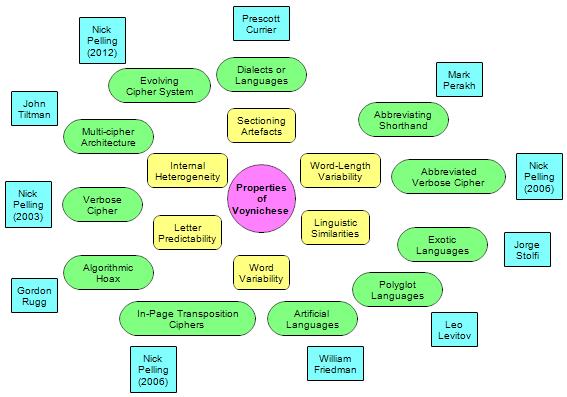Would we recognize the solution to the Voynich Manuscript even if it was right in front of us?
Some people believe that it continues to evade us because our expectations of where we should be looking are wrong: in other words, that, pace Henri Atlan (as quoted by Cornelius Castoriadis), we have got into the habit of looking beneath lampposts for our key because that’s where the light is better. The corollary is that after all this time, the actual solution is more likely to be lurking in the darkness, surely?
I’m not so pessimistic: we “moderns” have managed to use the primary evidence (i.e. that which is disclosed by the manuscript itself) to accrete a fairly substantial body of codicological evidence, which any new theory would need to address. While this hardly amounts to a monoptic “mainstream” viewpoint (just look at the debates I’ve had with Glen Claston), to a very significant degree it isn’t something you can easily brush aside. Yet the fact that Glen and I now broadly agree on most of the evolutionary stages through which the VMs passed en route to its final state is both wonderful (given our long-standing differences) and worrying (because it bolsters any tendency to intolerance).
And so our ongoing challenge is to work out whether our knowledge about the VMs is more solid and advanced than ever before (if we’re basically right), or more fragile and misguided (if we’re basically wrong). Still, we all persist in chipping away at the sheer face, hoping to trigger some kind of epistemological avalanche, whereby removing one tiny stone releases an entire cascade of unexpected evidence. As always, progress remains slow: but is this because the Voynich Manuscript’s encryption system is so hard, or because we’re hacking away at completely the wrong mountain?
Every once in a while, entirely unknown Voynich theorists swing into view: these have often been looking at and thinking about the Voynich Manuscript for years (if not decades), and bring with them a kind of fresh air of hope (privately, many Voynich researchers are jaded and pessimistic, but that’s a bit of a secret), but also fairly unsophisticated claims that we have seen close variants of in the past.
So, in the big scheme of things, Jody Maat’s newly-proposed way of reading the Voynich Manuscript is actually remarkably familiar: his interpretation of Voynichese as a kind of vaguely polyglot “Old Dutch” (it plainly isn’t “Old Dutch” otherwise) reprises Leo Levitov’s claims in very many ways, though you can also find echoes in it of various other Middle European Voynich ‘translation’ claims we’ve seen over the years – for example, Jim Child’s theory and Beatrice Gwynn’s theory.
All the same, just as with Brumbaugh in the 1970s, there are places where Jody’s reading does seem briefly to make sense, as if the pages were lit by a flickering candle: but having myself tried to duplicate his reading on other pages, this only seems to happen once or twice per page – not statistically significant. Just as with Levitov (and with Leonell Strong’s decipherment, to be honest), only by dramatically lowering the quality bar of what you are prepared to accept as “language” does it even remotely make sense.
I have often heard it said that it would somehow ‘make sense’ for a cipher’s plaintext to be written with copious misspellings – because, for example, it was the profusion of stock phrases (such as “HEIL HITLER”, of course) and formulaic weather reports that most helped the Allies crack Enigma. However, to do this to the degree required here would imply an anachronistic level of cryptographic sophistication. And for it to makes sense as a language would require a yet lower quality bar, dipping ever closer to nonsense or babble.
I’m sorry, Jody: for all your desire to read the Voynich Manuscript and the considerable empathy you feel with its subject matter, drawings, and author, I honestly don’t think this is the answer. The subtle genius of the Voynich Manuscript – and this is something that I’ve been pointing out for years – is that it was written in a cipher which had been constructed to resemble an unknown European language. What you are reading, then, is the covertext: the letters on the surface, while the actual meaning swims just beneath.
Please don’t feel bad about your having fallen into a deep intellectual trap – you are in excellent company!
